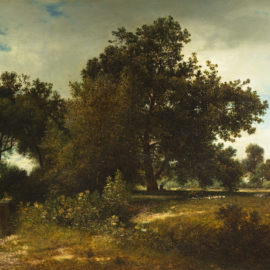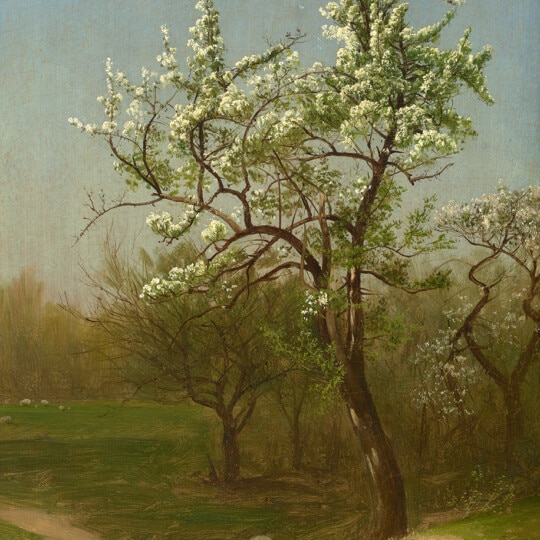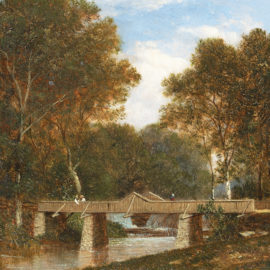Artist Biography
As a second-generation member of the Hudson River School, David Johnson experienced artistic success during the second half of the nineteenth century. The style of his rocky landscape scenes tended to coincide with whatever genre the current art market dictated as on trend, with his later works demonstrating a distinctly luminist influence.
By Chelsea DeLay
I. Biography
II. Chronology
III. Collections
IV. Exhibitions
V. Memberships
VI. Suggested Resources
VII. Notes
I. Biography
Born in New York City on May 10, 1827, David Johnson went on to become a skilled landscape artist who led a relatively quiet life.[1] Johnson was essentially a self-taught
As a second-generation member of the Hudson River School, David Johnson experienced artistic success during the second half of the nineteenth century. The style of his rocky landscape scenes tended to coincide with whatever genre the current art market dictated as on trend, with his later works demonstrating a distinctly luminist influence.
By Chelsea DeLay
I. Biography
II. Chronology
III. Collections
IV. Exhibitions
V. Memberships
VI. Suggested Resources
VII. Notes
I. Biography
Born in New York City on May 10, 1827, David Johnson went on to become a skilled landscape artist who led a relatively quiet life.[1] Johnson was essentially a self-taught artist up until 1845, but at the age of eighteen, he ceded to artistic conventions and enrolled at the National Academy of Design.[2] Under the instruction of mentors John William Casilear (1811–1893), John Frederick Kensett (1816–1872) and Jasper Francis Cropsey (1823–1900), Johnson soon began to paint landscapes of his native New York with a level of skill which enabled him to ride on the coattails of their success.
In 1849, the onset of Johnson’s artistic career was marked with a landscape painting entitled Hanes Fall, Kauterskill Clove, which was inscribed en verso, “My first study from nature–made in company with J.F. Kensett and J.W. Casilear.”[3] This year was also the first time Johnson began to exhibit his landscapes at the National Academy. His incorporation of a golden palette, carefully observed details, reflective rivers, and framing trees led to his classification as a second-generation member of the Hudson River School.[4]
The 1850s was a period that brought with it a stylistic shift for the artist, and it was evident that “uncompromising clarity and realism became the hallmark Johnson’s art.”[5] He visited New Hampshire for the first time in 1851, and the lure of the rocky terrain would continue to draw Johnson back well into the later years of his life. His exceptional portrayals of rock formations and landscapes did not go unnoticed, and Johnson’s talents were rewarded by the National Academy in 1859, when he was made an Associate member, and again in 1861, when he was elected Academician.
The peak of Johnson’s career occurred in the 1870s; as his painting style became tightly controlled, his brushstrokes were consequently almost imperceptible. “In the late 1870s and early 1880s…his main effort was to wed the intimate poetry of the Barbizon school with the precisionism and luminism which were almost central to his work.”[6] Up until the mid-1880s, Johnson had successfully kept his finger on the pulse of the art market, and effectively mastered the process of adapting his style to cater to the art world’s current taste.
It was most unfortunate that critics did not champion the more tonal nature of his later works, and an advertisement featured in The New York Times from 1890 gave notice of a public auction of his paintings presented by Ortgies & Company.[7] Such a large surplus of unsold works indicated Johnson may have encountered financial difficulties towards the end of his career; this notion was further supported when Johnson was forced to give up his New York studio in 1904. Only four years later, in 1908, Johnson passed away in his home in Walden, New York.
II. Chronology
1827 Born in New York, New York
1845–47 Registered as a student at the National Academy of Design
1849 Painted his first nature study with John Frederick Kensett and John William Casilear
1850 Briefly took painting lessons with Jasper Francis Cropsey
1851 First of many study trips to New Hampshire
1859 Elected Associate Membership to the National Academy of Design
1860 Visited Virginia to study the well-known Natural Bridge
1861 Elected Academician to the National Academy of Design
1874 Nominated to participate as a member of the Hanging Committee for the National Academy’s annual exhibition
1876 Awarded first class medal at the Centennial Exhibition in Philadelphia
1890 Two day sale of the artist’s unsold works conducted by Ortgies and Company at Fifth Avenue Art Gallery in New York
1894 Forced to move out his studio due to financial troubles
1899 Final year exhibiting with the National Academy of Design
1908 Passed away in Walden, New York
III. Collections
Amon Carter Museum of American Art, TX
Boston Museum of Fine Arts, MA
Brooklyn Museum of Art, NY
Cleveland Museum of Art, OH
Columbus Museum of Art, OH
Dallas Museum of Art, TX
De Young Museum, CA
Everson Museum of Art, NY
Frederick R. Weisman Art Museum, MN
George Walker Vincent Smith Museum, MA
Georgia Museum of Art, GA
Houston Museum of Fine Arts, TX
Memorial Art Gallery, NY
Metropolitan Museum of Art, NY
Munson-Williams-Proctor Arts Institute, NY
National Gallery of Art, Washington, DC
New York Historical Society, NY
Pennsylvania Academy of the Fine Arts, PA
Phoenix Art Museum, AZ
Portland Art Museum, OR
Reynolda House-Museum of Art, CA
Santa Barbara Museum of Art, CA
Smithsonian American Art Museum, Washington, DC
St. Petersburg Museum of Fine Arts, FL
Staten Island Museum, NY
The John & Mable Ringling Museum of Art, FL
The Nelson-Atkins Museum of Art, MO
Thyssen-Bonemisza Collection, Madrid, Spain
University of Michigan Museum of Art, MI
USC Fisher Gallery, CA
Wadsworth Athenaeum Museum of Art, CT
Yale University Art Gallery, CT
IV. Exhibitions
1849–99 National Academy of Design
1849 American Art Union
1861–82, 1892 Brooklyn Arts Association
1876 Centennial Exposition, Philadelphia, first class medal
1877 Paris Salon
1878 Massachusetts Charitable Mechanics Association, Boston, medals
V. Memberships
National Academy of Design, Associate, 1859; Academician, 1861
Artists Fund Society
VI. Suggested Resources
Falk, Peter. “David Johnson.” In Who Was Who in American Art: Artists Active between 1898 and 1947, 1738. Madison, CT: Sound View Press, 1999.
Howat, John. K. American Paradise: The World of the Hudson River School. New York: The Metropolitan Museum of Art, 1987.
VII. Notes
1. John I. H. Baur “‘... The Exact Brushwork of Mr. David Johnson,’ An American Landscape Painter, 1827-1908,” American Art Journal 12 (Autumn, 1980): 34, accessed June 25, 2012, http://www.jstor.org/stable/1594220.
2. Peter Falk, Who Was Who in American Art: Artists Active between 1898 and 1947 (Madison, CT: Sound View Press, 1999), 1738.
3. John. K Howat, American Paradise: The World of the Hudson River School (New York: The Metropolitan Museum of Art, 1987), 269.
4. John Wilmerding, American Light: Luminist Movement 1850–1875 (Washington, DC: National Gallery of Art, 1989), 108.
5. Baur 39.
6. Ibid, 62.
7. Howat, 269.
As a second-generation member of the Hudson River School, David Johnson experienced artistic success during the second half of the nineteenth century. The style of his rocky landscape scenes tended to coincide with whatever genre the current art market dictated as on trend, with his later works demonstrating a distinctly luminist influence.
By Chelsea DeLay
I. Biography
II. Chronology
III. Collections
IV. Exhibitions
V. Memberships
VI. Suggested Resources
VII. Notes
I. Biography
Born in New York City on May 10, 1827, David Johnson went on to become a skilled landscape artist who led a relatively quiet life.[1] Johnson was essentially a self-taught artist up until 1845, but at the age of eighteen, he ceded to artistic conventions and enrolled at the National Academy of Design.[2] Under the instruction of mentors John William Casilear (1811–1893), John Frederick Kensett (1816–1872) and Jasper Francis Cropsey (1823–1900), Johnson soon began to paint landscapes of his native New York with a level of skill which enabled him to ride on the coattails of their success.
In 1849, the onset of Johnson’s artistic career was marked with a landscape painting entitled Hanes Fall, Kauterskill Clove, which was inscribed en verso, “My first study from nature–made in company with J.F. Kensett and J.W. Casilear.”[3] This year was also the first time Johnson began to exhibit his landscapes at the National Academy. His incorporation of a golden palette, carefully observed details, reflective rivers, and framing trees led to his classification as a second-generation member of the Hudson River School.[4]
The 1850s was a period that brought with it a stylistic shift for the artist, and it was evident that “uncompromising clarity and realism became the hallmark Johnson’s art.”[5] He visited New Hampshire for the first time in 1851, and the lure of the rocky terrain would continue to draw Johnson back well into the later years of his life. His exceptional portrayals of rock formations and landscapes did not go unnoticed, and Johnson’s talents were rewarded by the National Academy in 1859, when he was made an Associate member, and again in 1861, when he was elected Academician.
The peak of Johnson’s career occurred in the 1870s; as his painting style became tightly controlled, his brushstrokes were consequently almost imperceptible. “In the late 1870s and early 1880s…his main effort was to wed the intimate poetry of the Barbizon school with the precisionism and luminism which were almost central to his work.”[6] Up until the mid-1880s, Johnson had successfully kept his finger on the pulse of the art market, and effectively mastered the process of adapting his style to cater to the art world’s current taste.
It was most unfortunate that critics did not champion the more tonal nature of his later works, and an advertisement featured in The New York Times from 1890 gave notice of a public auction of his paintings presented by Ortgies & Company.[7] Such a large surplus of unsold works indicated Johnson may have encountered financial difficulties towards the end of his career; this notion was further supported when Johnson was forced to give up his New York studio in 1904. Only four years later, in 1908, Johnson passed away in his home in Walden, New York.
II. Chronology
1827 Born in New York, New York
1845–47 Registered as a student at the National Academy of Design
1849 Painted his first nature study with John Frederick Kensett and John William Casilear
1850 Briefly took painting lessons with Jasper Francis Cropsey
1851 First of many study trips to New Hampshire
1859 Elected Associate Membership to the National Academy of Design
1860 Visited Virginia to study the well-known Natural Bridge
1861 Elected Academician to the National Academy of Design
1874 Nominated to participate as a member of the Hanging Committee for the National Academy’s annual exhibition
1876 Awarded first class medal at the Centennial Exhibition in Philadelphia
1890 Two day sale of the artist’s unsold works conducted by Ortgies and Company at Fifth Avenue Art Gallery in New York
1894 Forced to move out his studio due to financial troubles
1899 Final year exhibiting with the National Academy of Design
1908 Passed away in Walden, New York
III. Collections
Amon Carter Museum of American Art, TX
Boston Museum of Fine Arts, MA
Brooklyn Museum of Art, NY
Cleveland Museum of Art, OH
Columbus Museum of Art, OH
Dallas Museum of Art, TX
De Young Museum, CA
Everson Museum of Art, NY
Frederick R. Weisman Art Museum, MN
George Walker Vincent Smith Museum, MA
Georgia Museum of Art, GA
Houston Museum of Fine Arts, TX
Memorial Art Gallery, NY
Metropolitan Museum of Art, NY
Munson-Williams-Proctor Arts Institute, NY
National Gallery of Art, Washington, DC
New York Historical Society, NY
Pennsylvania Academy of the Fine Arts, PA
Phoenix Art Museum, AZ
Portland Art Museum, OR
Reynolda House-Museum of Art, CA
Santa Barbara Museum of Art, CA
Smithsonian American Art Museum, Washington, DC
St. Petersburg Museum of Fine Arts, FL
Staten Island Museum, NY
The John & Mable Ringling Museum of Art, FL
The Nelson-Atkins Museum of Art, MO
Thyssen-Bonemisza Collection, Madrid, Spain
University of Michigan Museum of Art, MI
USC Fisher Gallery, CA
Wadsworth Athenaeum Museum of Art, CT
Yale University Art Gallery, CT
IV. Exhibitions
1849–99 National Academy of Design
1849 American Art Union
1861–82, 1892 Brooklyn Arts Association
1876 Centennial Exposition, Philadelphia, first class medal
1877 Paris Salon
1878 Massachusetts Charitable Mechanics Association, Boston, medals
V. Memberships
National Academy of Design, Associate, 1859; Academician, 1861
Artists Fund Society
VI. Suggested Resources
Falk, Peter. “David Johnson.” In Who Was Who in American Art: Artists Active between 1898 and 1947, 1738. Madison, CT: Sound View Press, 1999.
Howat, John. K. American Paradise: The World of the Hudson River School. New York: The Metropolitan Museum of Art, 1987.
VII. Notes
1. John I. H. Baur “‘... The Exact Brushwork of Mr. David Johnson,’ An American Landscape Painter, 1827-1908,” American Art Journal 12 (Autumn, 1980): 34, accessed June 25, 2012, http://www.jstor.org/stable/1594220.
2. Peter Falk, Who Was Who in American Art: Artists Active between 1898 and 1947 (Madison, CT: Sound View Press, 1999), 1738.
3. John. K Howat, American Paradise: The World of the Hudson River School (New York: The Metropolitan Museum of Art, 1987), 269.
4. John Wilmerding, American Light: Luminist Movement 1850–1875 (Washington, DC: National Gallery of Art, 1989), 108.
5. Baur 39.
6. Ibid, 62.
7. Howat, 269.



